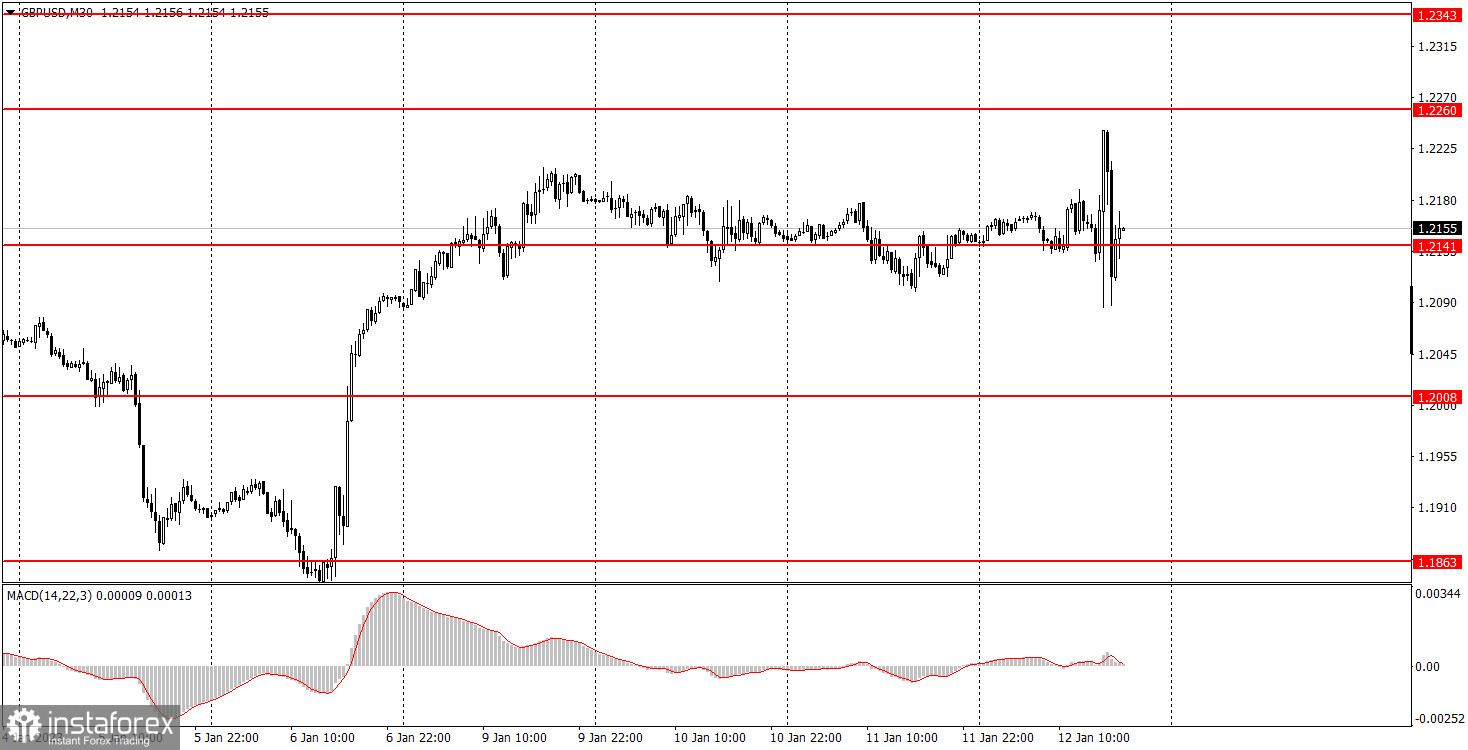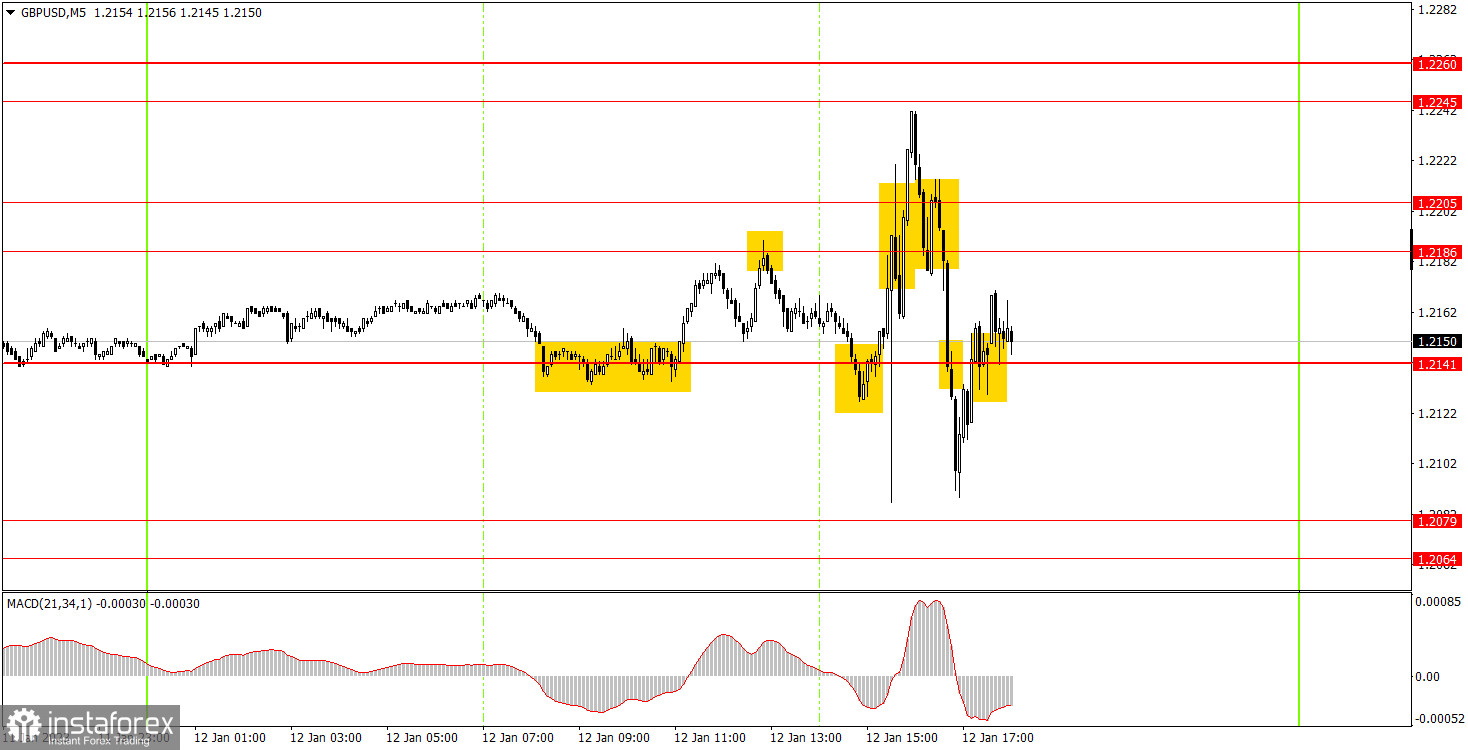Analyzing Thursday's trades:
GBP/USD on 30M chart

On Thursday, GBP/USD also showed absolutely calm movements at first, and then - "flights" in different directions. Most of the levels were ignored at the US trading session, but it's not because the levels are wrong or weak, but because volatility increased sharply, and the only significant factor was the US inflation report. Take note that the euro rose while the pound did not. I still believe that the pound's movements are more logical and reasonable than the euro. If traders really had reasons to sell the dollar on Thursday, then in the last 2 months there were not so many reasons for the euro to move up without a hitch. But at least the pound corrects from time to time on all charts. Unfortunately, it is impossible to form a trend line or a channel for the pound at the moment as well. So, the only thing left is to move at random. In principle, the trade is carried out by levels on lower charts.
GBP/USD on M5 chart

There were two trading signals in the European trading session, when it was still safe to trade. First, the pair rebounded from 1.2141, and then - from 1.2186. Though the distance between these levels was small, it was quite possible to earn ten points on these deals. And the third signal, around 1.2141, should not be triggered, because in 15 minutes the US inflation report was released, which caused a "roller-coaster" in the market. The pair was crossing all the levels on its way, but it failed to give any clear signal. Naturally, beginners should not open positions after such an important event. But Thursday is a good example of what the movements can be at important events and reports.
Trading tips on Friday:
On the 30-minute chart, GBP/USD started rising last Friday and in general, the uptrend remains. The British currency had good reasons to grow on Thursday, but it didn't rise at all. The movement is uneven. On the 5-minute chart, it is recommended to trade at the levels 1.1950-1.1957, 1.2008, 1.2057-1.2079, 1.2141, 1.2186-1.2205, 1.2245-1.2260, 1.2337-1.2343. As soon as the price passes 20 pips in the right direction, you should set a Stop Loss to breakeven. GDP and industrial production reports will be released in the UK on Friday. The GDP report is not quarterly, so traders probably won't have a significant reaction to it. The industrial production report has never provoked a strong reaction. In the US, we have the Consumer Sentiment Index from the University of Michigan, which can only provoke a move if the actual value deviates strongly from the forecasted one.
Basic rules of the trading system:
1) The strength of the signal is determined by the time it took the signal to form (a rebound or a breakout of the level). The quicker it is formed, the stronger the signal is.
2) If two or more positions were opened near a certain level based on a false signal (which did not trigger a Take Profit or test the nearest target level), then all subsequent signals at this level should be ignored.
3) When trading flat, a pair can form multiple false signals or not form them at all. In any case, it is better to stop trading at the first sign of a flat movement.
4) Trades should be opened in the period between the start of the European session and the middle of the US trading hours when all positions must be closed manually.
5) You can trade using signals from the MACD indicator on the 30-minute time frame only amid strong volatility and a clear trend that should be confirmed by a trendline or a trend channel.
6) If two levels are located too close to each other (from 5 to 15 pips), they should be considered support and resistance levels.
On the chart:
Support and Resistance levels are the levels that serve as targets when buying or selling the pair. You can place Take Profit near these levels.
Red lines are channels or trend lines that display the current trend and show in which direction it is better to trade now.
The MACD indicator (14, 22, and 3) consists of a histogram and a signal line. When they cross, this is a signal to enter the market. It is recommended to use this indicator in combination with trend patterns (channels and trendlines).
Important announcements and economic reports that can be found on the economic calendar can seriously influence the trajectory of a currency pair. Therefore, at the time of their release, we recommend trading as carefully as possible or exiting the market in order to avoid sharp price fluctuations.
Beginners on Forex should remember that not every single trade has to be profitable. The development of a clear strategy and money management is the key to success in trading over a long period of time.





















